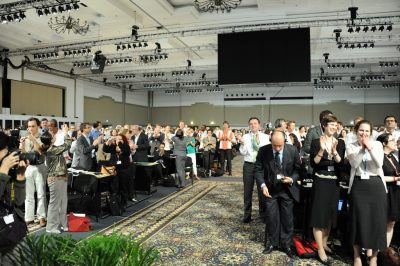It is very comprehensive – covers the ‘six-pack’ that negotiators were hoping for – and includes:
- A shared vision that recognises that deep cuts are required; calls for urgent action to meet a goal of keeping temperature increases below 2 degrees; a review to look into whether that goal should be 1.5 degrees; and realises that addressing climate change requires a paradigm shift towards building a low-carbon society.
- Mitigation commitments from developed countries and actions from developing countries that will be combined in a separate document – a bit like the annex to the Copenhagen accord. Like the Copenhagen Accord, this could include countries that are responsible for something like 80 percent of greenhouse gas emissions – while without even including the US, the Kyoto Protocol covers less than 30 percent of emissions. There are measures to enhance the transparency these actions and commitments. The agreement also urges developed countries to increase the ambition of their targets to a level consistent with what has been recommended by the Fourth assessment report of the IPCC.
- There are provisions for finance and a Green Climate Fund; adaptation; REDD+; opportunities for using markets; technology; consequences of response measures; capacity-building; and working towards legally binding protocols.
What is remarkable is that this is an agreement between nearly 200 countries. The only country that opposed consensus was Bolivia (which led to an interesting closing plenary). Because so much effort over the past few years has been invested in these negotiations, and because of the detailed consensus achieved, there is a huge amount of ‘buy-in’ for the Cancún Agreements.
What has been achieved is a good outcome for addressing climate change, and a good outcome for multilateral diplomacy.
Peter J. Wood is a Postdoctoral Fellow of Resource Management in the Asia-Pacific Program Research School of Pacific and Asian Studies at the ANU, and was an attendee at the COP16/CMP6 Conference in Cancún.


Peter,
I cannot see where the ‘breakthroughs’ are. If you could dot-point the specific gains I’d appreciate it.
Recognising that deep cuts are required is a shallow breakthrough. The issue is when will these cuts begin and by how much.
Recognising that eventually developing countries must make absolute cuts is not a breakthrough. It is an arithmetic fact of life. The ‘no regrets’ energy intensity reductions in China will bring energy efficiencies in that country to developed country levels by 2020. By 2030 however with bau China’s emissions will double.
The transparency breakthrough is not a breakthrough but a pathetic bargaining chip used by China and India. Both countries are developing enhanced capabilities to measure emissions and, of course, even a loose international agreement on emissions control requires confirmation of all cuts. It is a shallow gain.
What value any US commitment without a US ETS or carbon tax?
Climate adaptation transfers of $100b I think were offered at Copenhagen but, as with Cancun, I cannot see reference to who will pay. What kind of agreement is this?
I don’t understand the diplomatic jargon used on these occasions and really hope I am wrong. But did the Cancun meetings achieve much beyond not ending with stark disagreements?
Best, HC.
HC,
Until the last day of negotiations, it was unclear whether the obstructions and ‘bargaining chips’ provided by developed and developing countries would be resolved at all. As examples, because Japan announced that it would not inscribe its target into the second commitment period of the Kyoto Protocol, it was unclear whether China and other developing countries would allow any progress in the rest of the negotiations; the details of setting up a climate fund were very difficult – the G77 wanted it set up at Cancun instead of over the next year, there was disagreement about whether the World Bank would be a trustee, and developed countries were insisting that the fund should not be accountable to the Conference of Parties to the UNFCCC; there was resistance from countries such as China for any inscription of targets and commitments that would be separate from Kyoto. Even discussion of markets in the negotiating text was highly contentious.
Yes many of these issues, including transparency, were ‘bargaining chips’, but I don’t see how that makes them less important. I agree that the US commitment has little value without a carbon price, but that is something the US has to resolve themselves. Domestic policy is more important in terms of meeting commitments than any ‘legally binding’ agreement, the transparency provisions mean that when a country does introduce a carbon price, the rest of the world will know.
The question of who will pay for transfers, or who will enhance their mitigation commitments, is not resolved. In the present regime, this will have to be addressed from the bottom up. In my opinion, this could be facilitated by approaches that were originally designed to facilitate the private provision of public goods. This is not an easy problem, but it is a problem that we should focus on now that some of the deadlocks that have plagued negotiations over the past few years have been resolved.